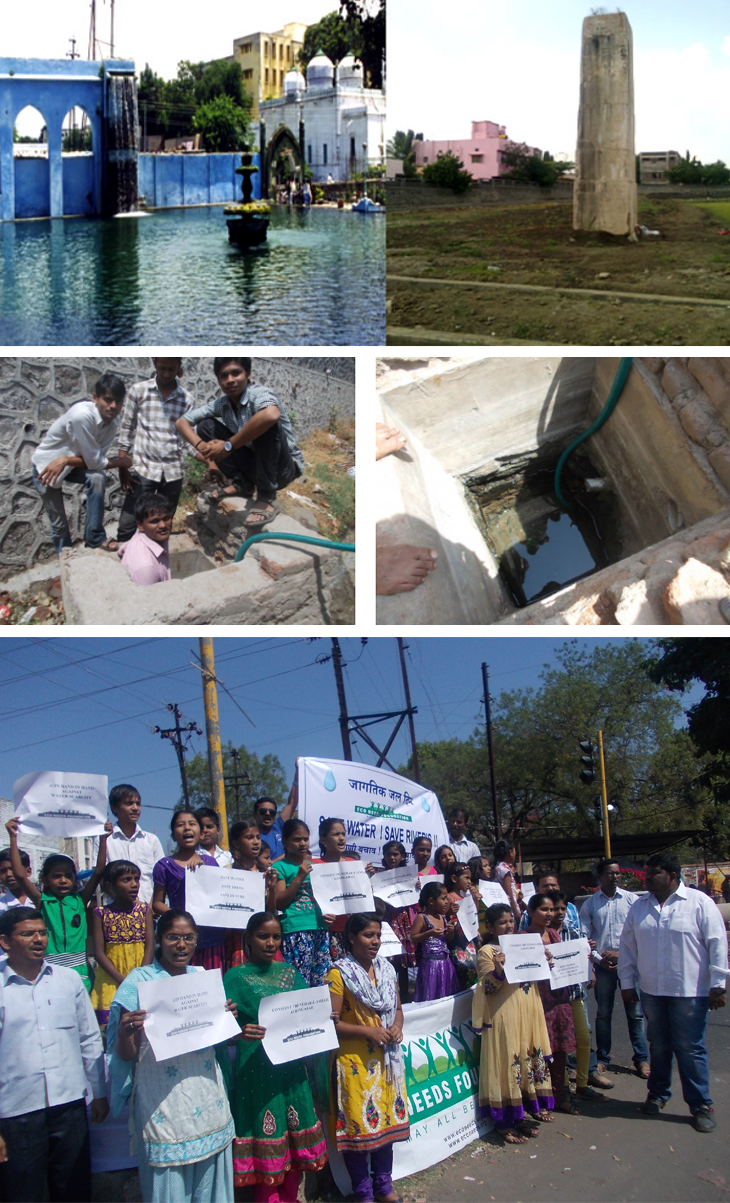Aurangabad Jalstrot Bachav Abhiyan (Aurangabad Water Resources Conservation Mission)
Nahar-e-Ambari
In the hydraulic history of Aurangabad, the system of canals was introduced by Malik Amber in 1617 A.D. Aurangabad township had to face the problem of scarcity of water and there were no big dams or water reservoirs in the vicinity. Personalities like Malik Amber, Shah Mehmood of Panchakki and Shah Ali Nehri were founders, designers and planners of those three famous, novel and useful aqueduct systems for the supply of water to the city. Irrespective of the prolonged span of 350 years the systems were stil1 functioning. The inhabitants of Aurangabad were being benefited by this water supply system for 350 years regularly without any tax. The construction of these canals started from the oldest era of Malik Ambar and after the age of Aurangzeb also. The old water supply system is the reminiscent of medieval period. The city of Aurangabad was having a number of Nahars of pure mineral subterranean drinking water. This practice of construction of such aqueducts continued from the period of Malik Ambar (1617) up to the time of Aurangzeb and Asif Jah (1803) for a period of about two centuries. The canals were also constructed one after another by the local kingdoms or by the richest people. The names of these canals are all related to the names of their builders.
Malik Ambar was the commander of the Nizam Shahi Kings and Subedar of Daultabad. He was a dynamic commander and a great engineer. His system of water supply is first of its kind and also the last. In the year 1604, he made “Khadki” (present Aurangabad) as his head-quarter and named it as Fateh Nagar. He introduced the system of water supply for the public utility, and this well organized system is known as Nahar-¬e-Ambari. Malik Amber in 1617 A.D., discovered subterranean water table of mountainous elevated valleys in north of Aurangabad. He practically manipulated and procured a stable perennial water supply for a population of 2 lakhs of people by constructing unique wonderful aqueduct by name KHAIR – E- JARI. On the high lands around the city from North, East and South wherever the circumstances allowed the engineers of the period brought down Nahars in Aurangabad city. During the military activities Malik Ambar discovered the Kham river valley and its large natural basin of about 150 sq. miles over head of a well planned and layout city. Malik Amber has designed the construction of the aqueduct like that of Nahare Zubeda in a very simple appearance and natural way underneath the river bed of Sawangi and Kham river which has got number of man holes over head called Abgir Nali up to Gaimukh. An earthen dam was constructed on the river Kham on the north of Aurangabad city. In 1636, when Aurangzeb was appointed as the subhedar of Deccan, he made Fateh Nagar as his capital and named it as Aurangabad. When he became the emperor of the Mughal Empire, he declared Aurangabad as the capital of the Mughal Empire. Owing to this reason the population grew faster and acute scarcity of water was felt. In order to supply water to the growing population he extended the system of water supply of Ambari and new canals were also dug. It is described that at the peak of Aurangazeb’s reign the population of Aurangabad was about two lakhs. Besides nahar-e-Ambari there were 12 (twelve) canals which were sufficient to supply ample water to the town, some of them are still functioning properly and rest of then can become permanent source of supplying water after the minor repairs.



Eco-Needs Foundation (ENF) is an organization of young people striving for environmental conservation and ECO-REVOLUTION.
It is a revolution entailing all round ecological development.
which includes economic, social, educational, cultural, health, technological development and conservation of water and other natural resources, and above all the holistic development of the ecology.
















